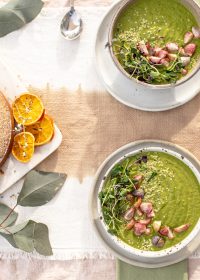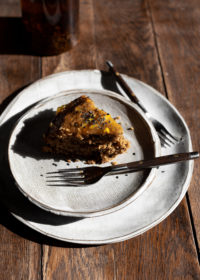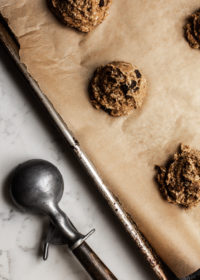Recipe: Raw Mexican Spiced Hot Chocolate

Día de los Muertos. I’ve always preferred this celebration over modern halloween because it’s all about honoring our ancestors and the sacred cycles of life and death. It reminds us to love this one life we have because everything is impermanent. Oh and there’s also that magical element that celebrates good food, drink and general feasting with family and friends. I can get down with that.
To celebrate, each year I start my day with this easy Mexican spiced hot chocolate using simple raw ingredients. And if you need more of a reason to celebrate with cacao, allow me to give you the lay out of nutritional benefits this magical medicinal plant possesses…
Nutritional Profile: Raw Cacao
The cacao bean (or cocoa as you may be more familiar with) comes from the genus Theobroma cacao. This tree produces beautiful brightly colored pods filled with tiny beans that can be broken down to nibs, that are then sun-dried and either roasted at high temperatures or kept raw before being ground into a fine powder. Raw cacao, that is unprocessed and unheated cacao beans, nibs, paste and powder, contains high levels of antioxidants. In fact, cacao has more antioxidant flavonoids than any food tested so far, including blueberries, red wine, and black and green teas. It has up to four times the quantity of antioxidants found in green tea. Health benefits of these antioxidants include:
- Promotes cardiovascular health – helps dilate bloods vessels, reduce blood clotting, improve circulation, help regulate heartbeat and blood pressure, lower LDL cholesterol, and reduce the risk of stroke and heart attacks.
- Protects from environmental and metabolic toxins by repairing damage caused by free radicals.
Cacao also contains a long list of essential vitamins, minerals, and brain-boosting compounds:
- Cacao is the highest whole food source for magnesium , which helps balance brain chemistry, builds strong bones, regulates heartbeat and blood pressure. Magnesium deficiency, present in 80% of Americans, is linked with hypertension, heart disease, diabetes and joint problems.
- Essential minerals – rich in a number of essential minerals alongside magnesium, including sulfur, calcium, iron, zinc, copper, potassium and manganese.
- High in the beauty mineral sulfur – sulfur builds strong nails and hair, promotes beautiful skin, detoxifies the liver, and supports healthy pancreas functioning.
- Serotonin – raises the level of serotonin in the brain acting as an anti-depressant, helping to reduce PMS symptoms, and promoting a sense of well-being.
- Endorphins – cacao stimulates the secretion of endorphins, producing a pleasurable sensation to the body and mind.
- Phenylethylamine – created within the brain and released when we are in love, acts as mild mood elevator and anti-depressant, and helps increase focus and alertness.
- Anandamide – “bliss chemical” – cacao contains both N-acylethanolamines, believed to temporarily increase the levels of anandamide in the brain, and enzyme inhibitors that slow its breakdown.
 Cacao: A Brief History
Cacao: A Brief History
The cacao tree has been cultivated in Mexico and Central – South America for thousands of years, and it has been so highly valued that was once the cacao beans were traded as currency. The Aztecs believed cacao to be of divine origin, and both they and the Mayans used the roasted bean in the famous beverage Chocolatl, together with vanilla, chiles and other flavorings. In the early 16th century, Columbus brought sacks of cacao back to Europe, but he did not realize its economic value. Then, in 1519, Cortez brought cacao back to Spain, and it was soon made into a luxury drink for the upper classes. By the 17th and early 18th centuries, chocolate was considered a cure for many illnesses, as well as a catalyst for provoking passion, although it was still too expensive for the general populace. Finally, in the 18th century, chocolate houses were established in London, making chocolate available to a broader spectrum of society, and their popularity quickly surpassed that of the coffee houses. Today cacao is planted on over 43,000 square miles worldwide. Forty percent of production is from Cote d’Ivoire, while Ghana and Indonesia produce about 15% each, and Brazil, Nigeria, and Cameroon provide smaller quantities. This barely scratches the surface of the history of this plant, for a more detailed account I recommend reading Sophie D. Coe’s A True History of Chocolate.
Different Varieties of Cacao
There are three main cultivar groups of cacao beans grown today:
- The Criollo group, which was used by the Maya, is the most rare and expensive of the three. Only 10 to 15% of cacao trees are Criollo, and they are small and difficult to grow. The chocolate made from the Criollo bean has a delicate and complex array of flavors. Often referred to as the “King of Cacao,” Criollo is highly prized and is used by many of the new “micro chocolate makers.”
- The Forastero group makes up about 70% of the cacao grown today. Forastero trees are easier to grow and significantly hardier than Criollo, resulting in more affordable beans. Well-prepared Forastero is what most of us are used to eating in chocolate.
- The Trinitario is a hybrid of Criollo and Forastero, and it makes up about 20% of the cacao beans produced today.
When purchasing your raw cacao powder, the company will tell you what type of bean it is and where it was grown. You will mostly find Ecuadorian varieties of the Forastero bean being sold by superfood companies. But like wine, I recommend getting your hands on different varietals and having a tasting party to experience the different flavors you find from each bean. It’s truly an art in itself.
Now what about Mexican Hot Chocolate?
The Aztecs, Mayans and Olmecs were the first to create their magical varieties of this chocolate beverage over 500 years ago, calling it xocatyl or chocolatl. The elixir was often mixed with maize, annatto, chiles and other spices, then poured from a high level down into another vessel to create the perfect foam on top, the magical ingredient that was revered as the most potent part containing aphrodisiac powers. Centuries later, when the Spanish conquistador Hernando Cortés brought this recipe back to Spain, the molinillo was created to simplify the foaming process. The molinillo, pictured below, is used to froth the elixir by rubbing the wooden handle vigorously between your palms. But for the sake of even more modern invention, your blender achieves this same result but with a less romantic experience.
Many versions of this recipe are quite popular in Mexico now, each region with it’s own signature variation. I love the combination of chiles and chocolate as it dilates the blood vessels and helps your body receive the cacao better. You can play around with different varieties of chile powders and add in layers of sweetness using your choice of raw honey, maple syrup and coconut crystals for healthier natural sugar options. However, you should really taste the bitterness of the cacao contrasted with the hot chiles and sweet cinnamon before adding more sugar.
When sipping this, close your eyes and feel the taste and texture of this warming drink. They say cacao can be a powerful consciousness-expanding teacher, can you hear the message she has for you? In honor of Dia de los Muertos, as you sip this magical elixir, give thanks to your ancestors and those who’ve weathered the journey before you.
 RAW MEXICAN SPICE HOT CHOCOLATE
RAW MEXICAN SPICE HOT CHOCOLATE
1 tbsp raw coconut butter
2-3 tbsp raw cacao powder
1-2 tbsp raw honey (to taste, depending on your sweetness preference)
1/4 tsp vanilla bean powder (about 1/2 bean scraped)
1/2 tsp cinnamon powder
pinch sweet chile powder
pinch cayenne pepper
pinch Himalayan pink salt
16oz almond milk
In a large mug, add the coconut butter, honey and cacao powder. Using a spoon, mix into a thick paste. Add in the spices and salt. Mix again until combined. Then, in saucepan, slowly heat the almond milk until hot, but not boiling. Remove from heat and slowly pour a small amount into the mug, stir the mixture until paste has become a dark thick liquid, then continue pouring the remainder of the almond milk on top. Use an electric frother, an old-school molinillo or throw this mix into your blender and whirl until frothy. Sprinkle with a light dusting of cinnamon and a tiny pinch of chile.
Maker’s Notes: If you need to a little help getting in the mood to prepare this medicinal beverage, flip on your stereo and crank up this Latin-inspired mix I’ve created. No, it’s not entirely Mexican artists, but a blend of my favorite Cuban, Peruvian, Brazilian and Argentinian artists, too! Guaranteed to get you feeling sultry and ready to dance. Listen here to Kitchen Mixtape No. 02 – Samba y Salsa.
Makes 1-2 servings
———————-
Note: Cacao can be very heating. For someone experience a pitta imbalance, cacao + chilies might be too heating for you right now! For a more soothing variation of this recipe, skip the chilies and add cardamom instead. If you drink dairy, a raw milk can also counterbalance the heating effects of cacao. For kapha, the addition of heat from the chilies balances out the richness of this drink and helps to digest this drink better, but keep an eye out on how much sweetener added.
 [wpmenucart]
[wpmenucart] Recipes: Align with Spring + A Giveaway with Anaya Home
Recipes: Align with Spring + A Giveaway with Anaya Home  Recipes: Black Sesame & Orange Cake
Recipes: Black Sesame & Orange Cake  Recipes: Garam Masala Chocolate Oat Cookies
Recipes: Garam Masala Chocolate Oat Cookies 